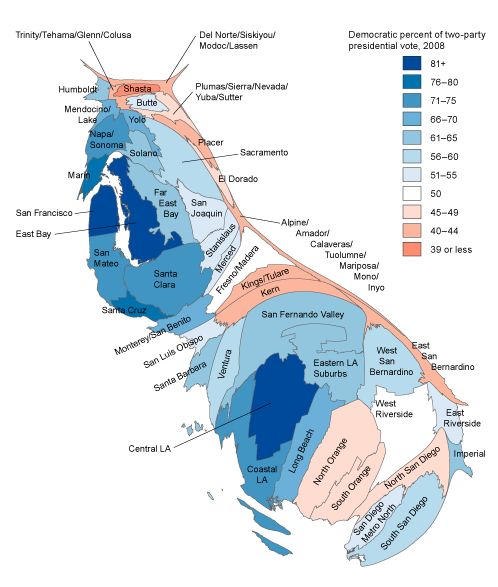Despite Economic Importance of Rural Areas, Urban Coast Dominates Calif.'s Political Leadership

Although California is the most populous state in the nation with just over 38 million people spanning a length of about 800 miles, its political leaders at the federal and state executive levels come from largely urban areas, specifically the Bay Area. This concentration of power calls into question the very nature of a representative government.
To look at these top political leaders in the U.S. Senate and in the state capital, one would assume that the Bay Area has proportionately many more people than anywhere else in the state. However, the Bay Area only accounts for 18 percent of the state’s population. Greater LA accounts for a much larger swath — 42 percent.
The two United States Senators, Dianne Feinstein and Barbara Boxer, made a name for themselves in the Bay Area. Feinstein is the former mayor of San Francisco and Boxer was a United States representative for cities just north of San Francisco. Governor Jerry Brown was born in San Francisco and is also a former mayor of Oakland.
Lieutenant Governor Gavin Newsom joins the list of former mayors of San Francisco. Attorney General Kamala Harris was born in Oakland and is a former district attorney of San Francisco. Nancy Pelosi, a congresswoman from San Francisco, is the highest-ranking female politician in American history to date with her tenure as speaker of the U.S. House; she is currently the House minority leader.
Political power emanating from urban areas is overrepresented in California’s national and state executive leadership, but does that come at the expense of rural communities?The geographical largess of California also corresponds with a diverse population. Priorities for voters in San Francisco may be much different than those of farmers in the Central Valley. Silicon Valley differs greatly from the Imperial Valley, and just how similar are the areas of San Diego County and the far reaches of Northern California, such as Eureka and Redding?
For instance, in 2012, 88.4 percent of voters in San Francisco County voted for Feinstein (D). Whereas in Kern County, a major agricultural producer about 300 miles southeast of San Francisco, Feinstein lost by 18 percentage point (58.7% to 41.3%). That is a 47-point difference in support for Feinstein, who has represented California in the U.S. Senate since 1992.
In the 2010 election cycle, Senator Boxer (D) lost by big points in Fresno, Madera, Merced and Stanislaus counties -- four of the biggest almond producing counties in the state. However, while Feinstein and Boxer are getting most of their votes from the coastal cities, the agricultural sector is still a priority for California's political leadership.
One can’t help but see the stark differences within populations in California. Driving up Interstate 5 through the Central Valley, the landscape is littered with signs that read, “Stop the Congress Created Dust Bowl” and “Stop the Costa, Pelosi, Boxer Dust Bowl” and “Tell Feinstein to Vote for the Water Bill”.
Rural counties may not be providing the most votes for Democrats from the Bay Area, but their effect on California's economy has made the political leaders sensitive to their needs.
In 2012 alone, California agricultural revenues exceeded $40 billion. So while the Democrats from the Bay Area continue to lose big in rural areas, they are still pursuing legislation that deals with rural priorities, in part due to the enormous effect on California's economy. Both Feinstein and Boxer cosponsored the California Emergency Drought Relief Act of 2014 in an effort to help farmers and rural communities in California (and Oregon) make it through the devastating drought.
But regardless of the legislation they pursue, there is still a persistent feeling among rural communities that California's political leadership is not representative of the whole state. Arising out of this dilemma is the movement for “Six Californias."
PARTY AFFILIATION BY POPULATION (Public Policy Institute of California):Spearheaded by Silicon Valley venture capitalist Tim Draper, this movement calls for California to be divided into six smaller and arguably more representative states --speaking to a growing belief that California has gotten too big to govern as one entity. In effect, under this proposal, the state of Silicon Valley would have the highest per capita income in the nation ($63,288), and neighboring Central California would have the lowest per capita income in the nation, right behind Mississippi, at $33,510.
Draper and supporters of Six Californias, many of whom hail from Silicon Valley, have a vested interest in seeing the creation of a separate state. Silicon Valley would be the wealthiest state in the U.S. and state taxes would remain local rather than being spread throughout California's rural sectors.
However, despite this reality, Six Californias seeks to brand itself as a a symbol of the disillusionment of the representative nature of California’s political leadership. By giving the inland rural areas their own statehood, Six Californias hopes its message will resonate with populations who see stark differences between the urban coastal communities and rural inland communities.
As population growth in California continues to cluster along the coastal urban areas (as illustrated above by the Public Policy Institute of California), the inland rural communities will have less political clout. The seat of top political power along the urbanized coast, especially the Bay Area, needs to recognize the consequence of this population concentration.
While the rural counties do not provide the most votes, they do provide California with other valuable resources: namely the food supply and water. Rural and urban Californians rely on one another.
A study reviewed by the Indianapolis Business Journal found that metropolitan areas tend to financially subsidize their less wealthy rural counterparts. And most of LA receives its water from the rural inland areas of the Sierra Nevadas. Hence the growing divide between urban and rural California needs to be addressed, as these communities live in a symbiotic relationship.
Photo Credit: Andrew Zarivny / shutterstock.com





